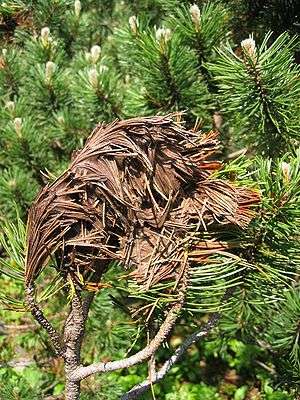Horticulture/Blights
< HorticultureBlight refers to a specific symptom that can be expressed by plants in response to infection by a plant pathogenic organism. It is simply a rapid and complete chlorosis, browning, then death of plant tissues such as leaves, branches, twigs, or floral organs.[1] Accordingly, many diseases that primarily exhibit this symptom are called blights. Several notable examples are:

Brown felt blight on mugo pine
- Late blight of potato, caused by the water mold Phytophthora infestans (Mont.) de Bary, the disease which led to the Irish Potato famine
- Southern corn leaf blight, caused by the fungus Cochliobolus heterostrophus (Drechs.) Drechs, anamorph Bipolaris maydis (Nisikado & Miyake) Shoemaker, incited a severe loss of corn in the United States in 1970.[2]
- Chestnut blight, caused by the fungus Cryphonectria parasitica'' (Murrill) Barr, has nearly completely eradicated mature American chestnuts in North America.
- Fireblight, caused by the bacterium Erwinia amylovora (Burrill) Winslow et al., is the most severe disease of pear and also is found in apple and raspberry, among others.
- Bacterial leaf blight of rice, caused by the bacterium Xanthomonas oryzae (Uyeda & Ishiyama) Dowson.[3]
- Early blight of potato and tomato, caused by species of the ubiquitous fungal genus Alternaria
- Rubber leaf blight
On leaf tissue, symptoms of blight are characterized by the initial appearance of lesions which rapidly engulf surrounding tissue. However, lesions of diseases that cause leaf spots may, in advanced stages, expand to kill entire areas of leaf tissue and thus exhibit blight symptoms.
References
- ↑ Agrios, George N. Plant Pathology. 5th ed. Burlington, MA: Elsevier Academic Press, 2005.
- ↑ Partridge, J.E. "Southern Corn Leaf Blight." 2003. 8 August 2006. http://nu-distance.unl.edu/homer/disease/agron/corn/CoSCLB.html
- ↑ Oda, M., Sekizawa, Y., and Watanabe, T. 1966. "Phenazines as Disinfectants Against Bacterial Leaf Blight of the Rice Plant." Applied Microbiology 14(3):365-367.
This article is issued from Wikibooks. The text is licensed under Creative Commons - Attribution - Sharealike. Additional terms may apply for the media files.